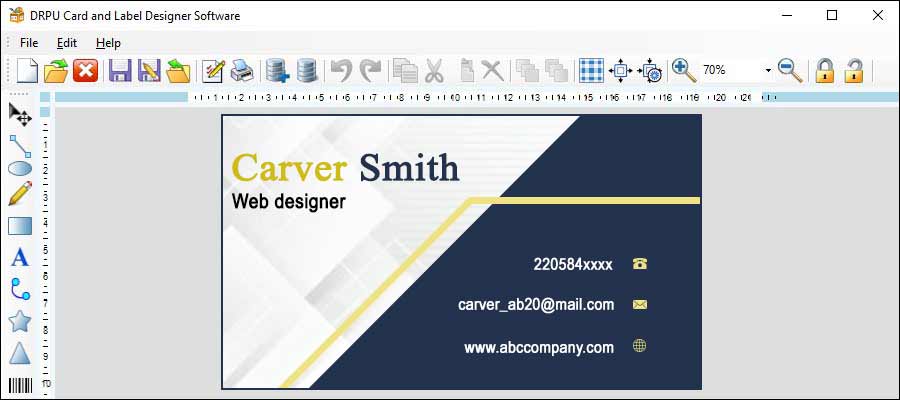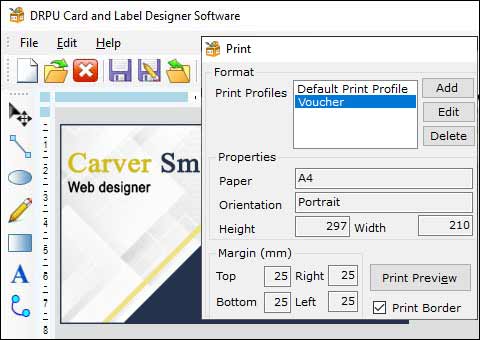Some Popular Options for Card Designing Software
There are various card designing software available in the market, ranging from free basic tools to expensive professional-grade software. Some of the most popular options include Adobe Photoshop, Adobe Illustrator, Canva, Microsoft Publisher, Corel DRAW, and Inkscape.

-
Adobe Photoshop:
Adobe Photoshop is a professional-grade software used for creating various graphic designs, including cards. It is a powerful tool that offers a wide range of features, including layering, color correction, and image manipulation. The software has a steep learning curve and may be overwhelming for beginners, but once you master it, the possibilities are endless.
-
Canva:
Canva is a free online tool that allows users to create custom designs, including cards. It has a user-friendly interface and a wide range of pre-designed templates, making it easy for beginners to create professional-looking cards. Canva also offers a premium version with more features, including access to a larger library of templates and the ability to upload custom fonts and logos.
-
Adobe Illustrator:
Adobe Illustrator is another professional-grade software designed for creating vector graphics. It is similar to Photoshop but focuses on creating designs that can be scaled without losing quality. Illustrator is popular among designers who work with logos, typography, and other complex designs.
-
Inkscape:
Inkscape is a free and open-source vector graphics editor that is similar to Adobe Illustrator and CorelDRAW. It offers a wide range of design tools and features, making it a popular choice among designers who work with vector graphics. Inkscape is also easy to use, making it a good option for beginners.
-
Microsoft Publisher:
Microsoft Publisher is a desktop publishing software that is part of the Microsoft Office suite. It is designed to create various print publications, including cards, brochures, and flyers. The software offers a wide range of templates and design tools, making it easy for beginners to create professional-looking cards.
-
CorelDRAW:
CorelDRAW is a professional-grade software used for creating various graphic designs, including cards. It is similar to Adobe Illustrator, but it offers more design tools and features, making it a popular choice among professional designers. CorelDRAW also offers a wide range of templates, making it easy for beginners to create custom designs.
When choosing a card designing software, it is important to consider your skill level, budget, and the features you require. Professional-grade software may be expensive and have a steep learning curve, but they offer more features and customization options. Free and low-cost software may be easier to use but may have limited features and templates.
Best Practices for Designing Cards for Print
Designing cards for print using card designing software requires attention to detail and an understanding of the printing process.The best practices for designing cards for print using card designing software:-

-
Use High-Quality Images: When designing cards for print, it's essential to use high-quality images to ensure that the final product looks professional. Use images with a high resolution of at least 300 DPI, and make sure they are in the correct color format (CMYK). Avoid using low-resolution images or images downloaded from the internet, as these can appear blurry or pixelated when printed.
-
Choose the Right Color Scheme: The color scheme you choose can have a significant impact on the final product. Make sure to choose colors that complement each other and match the theme of your card. Use a color wheel or online color palette tool to help you choose the right color scheme. When designing for print, use CMYK color mode instead of RGB to ensure accurate color representation.
-
Mind Your Margins: When designing cards for print, it's essential to consider the margins. Make sure to leave a sufficient amount of space between the design elements and the edge of the card to ensure that they don't get cut off during the printing process. The margin should be at least 1/8 of an inch.
-
Use Bleeds: Bleed is an important element of print design that ensures that the final product looks seamless. Bleed is the area outside of the trim line that is meant to be cut off after printing. Make sure to include a bleed of at least 1/8 of an inch to avoid having any white space around the edges of the card.
-
Choose the Right Fonts: When choosing fonts, make sure to use fonts that are easy to read and match the theme of your card. Avoid using too many different fonts as this can make the design look cluttered. Make sure to choose a font size that is appropriate for the size of the card.
-
Consider Printing Method: When designing cards for print, it's important to consider the printing method. Different printing methods require different file formats and color modes. Make sure to ask your printer about their printing requirements before designing your card. If you're using an online printing service, they usually provide templates and printing guidelines that you can follow.
-
Proofread Your Design: Before sending your design to the printer, make sure to proofread it for errors. Check for typos, spelling mistakes, and grammar errors. Double-check the placement of design elements and the accuracy of the colors. It's always a good idea to print a test copy to make sure everything looks as intended.
Designing cards for print using card designing software requires attention to detail and an understanding of the printing process. Use high-quality images, choose the right color scheme, mind your margins, use bleeds, choose the right fonts, consider the printing method, and proofread your design. By following these best practices, you can create professional-looking cards that meet your needs.